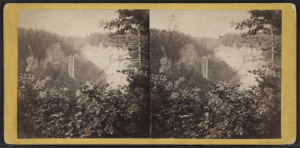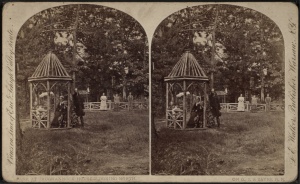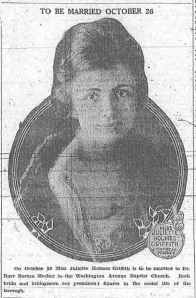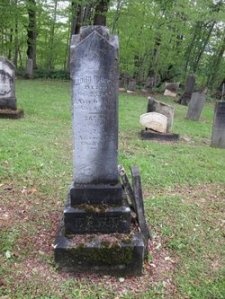A Note to My Readers: Brick walls can drive any genealogist…well…UP the wall! And we all know that brick walls are a big part of our reality. So most of us are at one point or another…digging around it or climbing up it or trying to tear it down. Sometimes brick by brick and sometimes with a big old stick of dynamite. And sometimes…you just have to walk around it and be prepared to visit the neighborhood because there is no “aha” moment waiting on the other side. And no ancestor waiting there patiently who asks, “What kept ya”?
My latest brick wall has a big old sign on it…
ORINDA BENNETT – PRIVATE PROPERTY. Darn.
Actually it’s not so much a brick wall as it is a gated community. The family name is on the gate and I can see the quaint buildings of the old whaling seaport with the bobbing masts in the harbor through the fence. BENNETT, TOBEY, JENNEY, JENNINGS, ESTES, CHACE, JAMES, WING are all familiar names in my ancestral stomping grounds of Dartmouth/New Bedford/Fairhaven, Massachusetts and Tiverton, Rhode Island. They are all “in there” and my family free pass is still good…aren’t I the fifth great granddaughter of New Bedford pioneers Isaac Jennings and Ruth Estes? That practically makes me Yankee Royalty.
Several years ago I tackled my Jennings ancestry beginning with my great great grandfather, Daniel J. Jennings. Daniel and his wife, Harriet J. James Jennings had settled in Auburn, New York in 1851. I grew up in Auburn and never knew that my father’s family history took me back so far in Auburn’s history. Daniel was born in New Bedford in 1820 to Samuel B. Jennings and his wife, Betsey Albert. The Jennings were typical of the other folks in New Bedford…tradesmen, merchants, seamen, tailors, bankers, doctors and the occasional farmer. And ultimately very transparent to research. Births, marriages and deaths and the family relationships all as neatly situated as the row of buildings along Water Street in New Bedford.
“Good Day, Grandfather Jennings and many thanks for the comfort of your hearth and home.” My Jennings brethren fairly flung open the doors to their home on 84 Linden Street and shared a meal with their granddaughter as if they knew the distance was not mere leagues of sea and miles of land, but across the expanse of time itself. Whatever wall appeared, it seemed that a Jennings was there to dismiss it and take me onto the next generation.
I began to know not just the Jennings, but the expanding tree of family as the marriage records revealed my New Bedford roots. Daniel’s brother, Adoniram, walked the streets of New Bedford with me…past his blacksmith shop and down to the harbor where their seafaring brother, Master Mariner Edmund Estes Jennings, greeted us from his ship the “E. Nickerson”. Their footloose brother, David H. Jennings, a mason by trade…and an accomplished inventor and tinkerer…made his home alternately in his New Bedford home and in Union Springs, New York with the fifth Jennings brother, Nathan S. Jennings, and for a time with his sister Clarinda and her husband, Nathan Adams in Altoona, Pennsylvania. Many thanks, Uncle David, for your wandering nature. It cinched together your family as neatly as one of your clever inventions.
As fortune would have it, the family history of Daniel’s wife, Harriet J. James, seemed to be as spare as a Yankee’s purse. The Jennings came and went in each other’s lives with utter regularity in central New York and indeed in New Bedford. Try as I might, using all of my best skills and resources, Harriet was just Harriet J. James, wife of carriage maker, Daniel Jennings. She was born in New York state, but interestingly, she was married in New Bedford on May 21, 1843.

New Bedford Register 24 May 1843
That left me with two places to search for the James family. It was a start. A very meager one…as meager as the notice of her death. Not even a mention of her children, never mind siblings.
New York state is a big place to research, but the best place to start. The Federal Censuses were very nice and all, but not revealing so I was on to the New York State Censuses of 1865 and 1875. 1865 was more of the same information…affirming, but no new insight. In 1875, the first brick fell. There was Daniel with Harriet. Harriet born in CAYUGA COUNTY! and the Jennings children…and one “Elmira James”…SISTER! And so fell the second and third bricks. Elmira, the tailoress…spinster…born in Massachusetts….living with her SISTER!
Another wanderer, my Aunt Almira James! And like my Uncle David Jennings…a critical thread to complete the family tapestry. Following Almira through the previous censuses, I found her in 1870 living in Ithaca, New York with Cornelius and Eliza Personius. No relationship is given and the birth state is said to be New York, but Almira is a tailoress. And not to be dismissed, Eliza is just a couple of years older and children in the household with the last name of Russell. Russell is the middle name of one of her sister Harriet’s daughters. Working backward to the 1860 census, I found 45 year old Almira living with her brother, Edwin W. James in Ithaca, New York who is a painter. She is a tailoress, born in New York state and a “pauper”. Edwin is also cited as born in New York state.
One more federal census to go before women in a household are not specifically named and become a hash mark in a male headed household! On to 1850. And Newfield, Tompkins County, New York and the household of John T. James and his family. John is a painter. A PAINTER! and next door to him is HIS younger brother, William who is also a PAINTER…and William’s father-in-law, Samuel Martin…ANOTHER PAINTER! John’s birth location is Connecticut, and William is New York. And Almira James is there. Hello, Aunt Almira. It’s so nice to see you again. A timeline of the birth dates and places is in order because clearly the James’ parents had been migrating from Massachusetts through Connecticut and on to New York state.
Brother, O Brother, Where Art Thou?
But first. Could there be some other James men in Tompkins County or Cayuga County? After all, some of the known James men were born in New York, not to mention Harriet who was reported to be born in Cayuga County in the 1865 New York State census. And there in 1850 living in Tompkins county…bordering Cayuga County….were Almira and John and William and Edwin James! A quick trip to my Nespresso machine and I was ready to tackle the search for James male siblings in 1850. I barely stung my lips with the steaming coffee when I found an Arnold James in Caroline, Tompkins County…just a short distance from Newfield…a distance hardly worth the term “distance”. Arnold was enumerated as a farmer…but doggone-it…he was born in Massachusetts and was of the right age to be a sibling of John, Almira, William, Edwin and Harriet. (And someday if I can prove it…Eliza Personius of Ithaca!).
The Timeline Analysis
While there is information “out there” that there are other siblings…sisters…, I don’t have anything concrete on those individuals so I took what I had and created a timeline of birth dates and places to confirm this family group and to analyze the migration of this James family.
- Arnold James was born in Bristol County, Massachusetts in 1808.
- John T. (Tobey) James was born in Connecticut in 1811.
- Almira James was born in New York (0r Massachusetts depending on what she reported in the census) in 1815.
- Harriet J. James was born in Slaterville, Tompkins County, New York on 20 August 1820 according to her death certificate.
- William Henry James was born in Cortland, New York according to the 1855 New York State census. His birth date according to his death records is February 5, 1826.
- Edwin W. James was born in New York state circa 1829.
Almira (also spelled Elmira) is the unifying James sibling. Unmarried, she lived with all of her James family siblings and is a tailoress all of her adult life. Her age remains consistent to her birth year in each census though she states both Massachusetts and New York as her place of birth. She is called “sister” in Harriet’s Auburn, NY household in 1875. That will do.
Three of the brothers, John, William and Edwin were all painters. An important clue. I followed the James brothers and discovered that the word “painter” was a bit too generic. They weren’t slapping paint from Home Depot on barns or frame homes situated in the drumlins of central New York. They were artists – graining…guilding…painting frescoes and applying decorative plasters in churches, public buildings and in the homes of newly rich. And just to add one more delicious stroke of the James brush….21 year old Edwin James lived with Nathan S. Jennings…his sister Harriet’s brother-in-law…in Union Springs in 1850. And Nathan was a noted painter in his area…specializing in graining, guilding, frescoes and decorative plastering.
But what of the farmer, Arnold James, from Newfield? Is age or place of birth…or proximity of residence….proof enough of the relationship? Further research…back to the 1865 New York state census which gives his occupation as PAINTER. And his burial notes from YATES Cemetery in Caroline states that Arnold was Justice of the Peace in 1868 in SLATERVILLE…the birthplace of his sister, Harriet. Check.
The next generation of James family members in central New York provided more proof. Visits with siblings, cousins and aunts and uncles are recorded in Ithaca and Auburn, New York area newspapers and further demonstrate their parents’ relationships. Short of the availability of a descriptive obituary which recounts family members and/or a brief history, details from a family bible…or birth or death certificates or a will, the collected data provided a strong path to conclude that Arnold, John, William, Edwin, Almira and Harriet were siblings.
The James family obviously had a journey…at least from Massachusetts and their birth dates and places clearly show that they were very young when the trek began or were born in central New York where their parents finally settled. And who are the parents? And where are they? Their children were a challenge to document and that makes their parents the next brick wall.
While all of this cobbling was going on, I had sent the wheels in motion in Albany, New York. I sent away for the 1890 death certificate of Harriet J. James Jennings. For some reason, the normal one month turnaround ended up being seven. Blame it on government cutbacks… Whatever the reason, I had done the work on Harriet’s family and when the certificate arrived, it provided the names of her parents…Webster James, Jr. and his wife, Orinda.
All Roads Lead to New Bedford
The envelope was barely open and the certificate read and I was on http://www.familysearch.org, ancestry.com, americanancestors.org, fultonhistory.com, genealogybank.com and GOOGLE to search for anything on Webster and his wife. One record. Just one, but it was enough. Webster James, Jr. married Orinda BENNETT in New Bedford, Massachusetts on March 7, 1807. That’s it. No “son of” or “dau of”. But enough. This was Bedford after all. And I cut my teeth on Jennings research in New Bedford. Yeah, right.
I did find a Webster, Sr. in a 1779 broadsheet ad in Providence, Rhode Island…as a bookbinder…and where Webster, Jr. was reportedly born. That’s good.

U S Chronicle 7 Jul 1803 Norwich Connecticut
Webster James Paper Hanging Manufacturing
Perusing more old New England newspapers and hoping to find more on Webster James, I found a notice in the July 14, 1803 U. S. Chronicle out of Norwich, Connecticut that Webster James….sailing from Providence to Norwich, Connecticut “lately arrived and moored in good harbor”…”The subscriber’s intention is to try once more to establish the Paper Hanging Manufactory, praying the public would encourage our home manufactures”. Further research, of course, must be done…this could be Webster, Sr. or Jr., but it most definitely provides a connection to the birth of John T. James and his stated birthplace of Connecticut. AND the very likely family trade of artisan painters that John, William, Edwin and at one time, Arnold embraced.
Orinda Bennett James lived until at least 1850. She is in the 1850 federal census in Whitestown in the Whitestown Asylum in Oneida County, New York…an insane pauper. While I have no concrete information, lore is that she died there alone in 1852. And what of Webster? A trip to the Ithaca area is in order and hopefully a random archive will surprise me with the fate of Webster James and his wife, Orinda Bennett. Once and for all.
Which leads me to New Bedford. And BENNETT. And the New Bedford Whaling Museum Research Library and the BENNETT family papers (1765-1908). And finding my BENNETT ancestors waiting and asking…
“What kept ya?”
Deborah Martin-Plugh
Author, Historian and Genealogical Researcher
(c) Copyright 2012. All Rights Reserved
 Way soldier, David Robinson (1740-1823) my paternal 5x great grandfather and his wife, Polly Raynor (1751-1824). They came to Lansing, Tompkins County from Suffolk County (Long Island) around 1790. With them they brought their children including my 4x great grandmother, Jerusha.
Way soldier, David Robinson (1740-1823) my paternal 5x great grandfather and his wife, Polly Raynor (1751-1824). They came to Lansing, Tompkins County from Suffolk County (Long Island) around 1790. With them they brought their children including my 4x great grandmother, Jerusha.



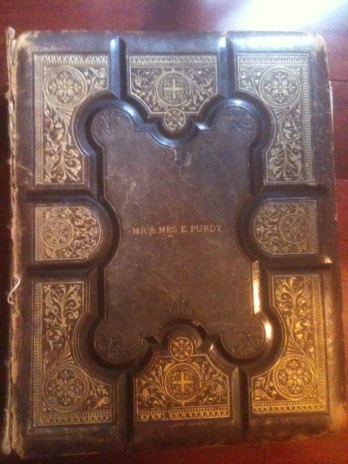
 1898, she had been a widow for ten years and pasted not one, but two newspaper clippings of Samuel D. Purdy’s death into her bible. By then she had remarried to a widower, Charles R. Smith, and relocated from Enfield to Ithaca, but she clearly maintained her Purdy and Enfield relationships. Perhaps she felt her matrimonial bible was not just her anchor of faith, but it also would serve as a treasured family time capsule. A remembrance of her and our entangled family history. The tiny, distinguished and iron-willed woman who her descendants recall as Mrs. E. A. Smith of 309 Eddy Street, Ithaca, New York.
1898, she had been a widow for ten years and pasted not one, but two newspaper clippings of Samuel D. Purdy’s death into her bible. By then she had remarried to a widower, Charles R. Smith, and relocated from Enfield to Ithaca, but she clearly maintained her Purdy and Enfield relationships. Perhaps she felt her matrimonial bible was not just her anchor of faith, but it also would serve as a treasured family time capsule. A remembrance of her and our entangled family history. The tiny, distinguished and iron-willed woman who her descendants recall as Mrs. E. A. Smith of 309 Eddy Street, Ithaca, New York. So…what is Libbie telling me with her inclusions? In my many trips to Enfield, I carried with me the 1866 map which indicated where Samuel D. Purdy’s mercantile – cum – U.S. Post Office and carpentry shop stood in Enfield Center. It was easy to identify the site of his business operation, but his obituary said he had a farm. On East Hill. Samuel bought and sold multiple parcels over his lifetime as an Enfield resident and I realized that I didn’t clearly understand exactly where his ‘farm’ on East Hill stood.
So…what is Libbie telling me with her inclusions? In my many trips to Enfield, I carried with me the 1866 map which indicated where Samuel D. Purdy’s mercantile – cum – U.S. Post Office and carpentry shop stood in Enfield Center. It was easy to identify the site of his business operation, but his obituary said he had a farm. On East Hill. Samuel bought and sold multiple parcels over his lifetime as an Enfield resident and I realized that I didn’t clearly understand exactly where his ‘farm’ on East Hill stood. With all of these elements…references in transactions dating back to the 1850’s to Military Lot 53, Lots No. 52, 60 and 61 owned by the Purdys and consulting a 1920 plot map of the Enfield area, I will take Grandma Smith’s ‘hint’ and begin to diagram the mentioned lots, neighboring landowners, dates to develop the history and timeline of the Purdy properties.
With all of these elements…references in transactions dating back to the 1850’s to Military Lot 53, Lots No. 52, 60 and 61 owned by the Purdys and consulting a 1920 plot map of the Enfield area, I will take Grandma Smith’s ‘hint’ and begin to diagram the mentioned lots, neighboring landowners, dates to develop the history and timeline of the Purdy properties.